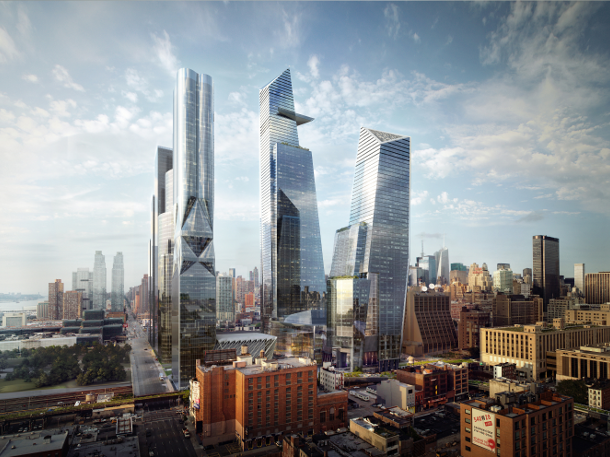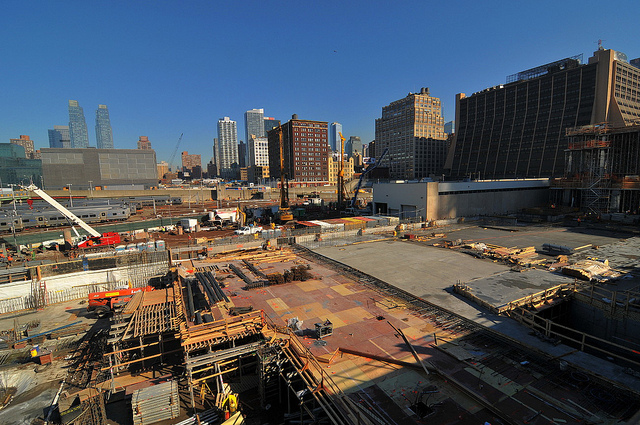
The area between 30th and 34th Street overlooking the Hudson river is preparing to become a new landmark in NYC’s sustainable urban landscape with the $20 billion Hudson Yards Project emerging in Chelsea. The project will be “the largest private real estate development in the history of the United States and the largest development in New York City since Rockefeller Center.”The project is being built entirely on an artificial foundation over an already existing rail yard. Not only will the Hudson Yards be a huge project resulting in a complex of open spaces and modern buildings, it will also be a milestone in sustainable building in New York City.
SUSTAINABILITY TAKES THE SPOTLIGHT
- 100 shops
- 20 restaurants
- 5 office towers
- A 150 room luxury hotel
- A public school
- Parks
- Public squares
- A multi-use cultural venue to host shows such as New York Fashion Week
The area is being built with sustainability in mind, aiming to reduce consumption of non-renewable resources, minimize waste, and create a healthy and productive environment.Smart data collection: Urban data is one of the catchwords of future sustainable building. By collecting data of various kinds – for instance traffic patterns or air quality – citizens and companies can predict future patterns and thus manage resources more efficiently. The key question is: How do people interact with the built environment?To find this out, New York University’s Center for Urban Science and Progress (NYU CUSP) along with Oxford Properties Group and Related Cos. will install a fiber loop and thousands of sensors in the Hudson Yards buildings. Together with information from rooftop satellites, wireless responders, and two-way radio communications services, these smart add-ons collect and analyze all data around traffic patterns, pedestrian flow, air quality, energy use and other indicators in order to improve both the inhabitants’ daily life and conserve resources. “The goals here tie back to the center’s mission, which is to use big data to make cities better places to live,” says Dr. Constantine Kontokosta, deputy director of the Center, adding that the collection of any personal data would be voluntary.Improving energy efficiency: 10 Hudson Yards and 30 Hudson Yards are the standout buildings of the project in terms of efficient energy use. These office buildings explore such a combination of innovative tools as to put them on track to be two of the most energy efficient buildings in Manhattan when they are completed.A few examples of efficiency include:
- “Daylight harvesting” – the automatic dimming of artificial lighting to complement natural sunlight levels – not only saves energy but also creates a more natural lighting environment.
- Occupancy sensors and timers turn off lights when and where they are not needed.
- Intelligent energy conversion helps use existing resources better; the buildings are slated to have elevators with highly efficient permanent magnet motors, which can capture energy expended for braking and regenerate it back into the building’s electrical system
 Intelligent garbage disposal: Basic vacuum waste collection systems have already existed for decades, to be seen, for instance, in facilities on Roosevelt Island or Disney World in Orlando. However, with ongoing urbanization, this model of collecting and storing garbage in an environmentally friendly way has gotten its second wind in big cities. The buildings at the Hudson Yards will be equipped with a pneumatic tube system, which separately transports organics, recyclables, and trash at 45 miles per hour to a nearby dispensary. This eliminates the need for garbage trucks in the area. The disposal system allows for organic food-service waste to be intelligently converted to dry fertilizer on-site.Implementation of microgrids: A microgrid is a localized grouping of electricity sources that can operate both with the traditional centralized grid as well as autonomously. This means that the Hudson Yards buildings can exchange electricity resources as well as interact with each other to share in temperature regulation. The same concept applies to the thermal microgrid, which will be installed, enabling the buildings to exchange hot and chilled water efficiently.
Intelligent garbage disposal: Basic vacuum waste collection systems have already existed for decades, to be seen, for instance, in facilities on Roosevelt Island or Disney World in Orlando. However, with ongoing urbanization, this model of collecting and storing garbage in an environmentally friendly way has gotten its second wind in big cities. The buildings at the Hudson Yards will be equipped with a pneumatic tube system, which separately transports organics, recyclables, and trash at 45 miles per hour to a nearby dispensary. This eliminates the need for garbage trucks in the area. The disposal system allows for organic food-service waste to be intelligently converted to dry fertilizer on-site.Implementation of microgrids: A microgrid is a localized grouping of electricity sources that can operate both with the traditional centralized grid as well as autonomously. This means that the Hudson Yards buildings can exchange electricity resources as well as interact with each other to share in temperature regulation. The same concept applies to the thermal microgrid, which will be installed, enabling the buildings to exchange hot and chilled water efficiently.
A NEW ERA OF SUSTAINABLE BUILDINGS
Hudson Yards is early in the game to some of these innovative new ideas in sustainability, but already many are beginning to see wider use and application.In spring of 2014, the US Department of Energy announced up to $7 million in funding to develop the design of community-scale microgrids. “Improving the resiliency of the electric grid is essential to moving the nation towards a cleaner and more secure and efficient energy future,” said assistant secretary for electricity delivery and energy reliability Patricia Hoffman.Using smart data is at an early stage but is also set for increased use in the future. “We can’t even begin to conceive all the applications that this data might be used for,” said Charlotte Matthews, vice president of sustainability for Related Companies.The Hudson Yards Project is about to inaugurate a new era of sustainable building in New York City and beyond. If future buildings can take this project as a roadmap, the city and the world will be well on its way to a more sustainable future.

